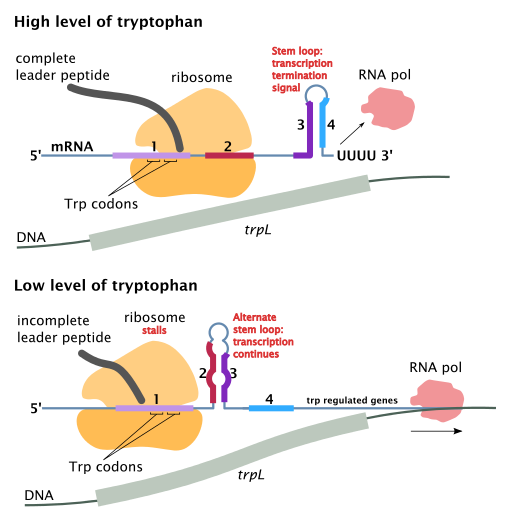Attenuation of transcription: the trp operon
Our last example of gene regulation in prokaryotes uses a mechanism of action that is unique to prokaryotes: transcriptional attenuation. In attenuation, instead of a full RNA being transcribed, a shortened (or attenuated) version is transcribed instead.
The trp operon is an example of attenuation. The trp operon includes five structural genes that are needed for the synthesis of the amino acid tryptophan. But the enzymes encoded by these genes are not needed if there are already high levels of tryptophan in the cell. The trp operon is negatively regulated by a repressor. But it uses attenuation as a second method of negative regulation.
Trp operon attenuation uses the action of the ribosome to terminate transcription early! That’s pretty unusual since we think of translation happening after transcription. So let’s look at how that’s possible.
Recall two things from our discussion of transcription in prokaryotes:
- Transcription and translation can happen simultaneously, with the 5’ end of the RNA being translated even as the 3’ end is still being transcribed.
- Rho-independent terminators work because a hairpin structure forms in the RNA and causes the transcription machinery to dissociate, or fall apart.
The trp operon RNA has a “leader” region upstream of the first structural gene. The leader region has four important regions as shown in Figure 19. Regions 2, 3, and 4 are complementary and can base pair in various ways: Regions 2 and 3 can base pair, or regions 3 and 4 can base pair. When regions 3 and 4 base pair, they form a terminator structure and transcription ends prematurely – before the structural genes are transcribed! The terminator structure is called the trp attenuator.

So what about region 1? Region 1 includes a short open reading frame with multiple tryptophan codons. When there is lots of tryptophan in the cell, the ribosome translates the 5’ leader just fine. The presence of the ribosome ties up region 2, leaving 3 and 4 to pair and form the terminator. That means lots of tryptophan = short RNA. This is shown in the top of Figure 19.
When there is little tryptophan in the cell (Figure 19, bottom), the ribosome gets stuck at the tryptophan codons because there aren’t enough tryptophan-charged tRNAs for translation to proceed. This parks the ribosome squarely on top of region 1. Region 2 is freed up to pair with region 3, so the terminator hairpin does not form. Low tryptophan = long RNA = structural genes can be translated.
Test Your Understanding
Ribosome-mediated transcription attenuation is a mechanism of gene regulation that is unique to prokaryotes, because it depends on simultaneous transcription and translation. Ribosome-mediated attenuation does not happen in eukaryotes since transcription occurs in the eukaryotic nucleus and an RNA must be exported to the cytoplasm to be translated. The ribosome is not present when transcription is occurring.
In trp operon example, the ribosome mediates transcriptional termination, but there are other mechanisms of attenuation in bacteria as well. For example, in some versions of attenuation, the presence of a small molecule affects the formation of a terminator hairpin instead of the ribosome.
Test Your Understanding
Media Attributions
- Trp operon attenuation © Histidine via. Wikipedia is licensed under a CC BY-SA (Attribution ShareAlike) license

